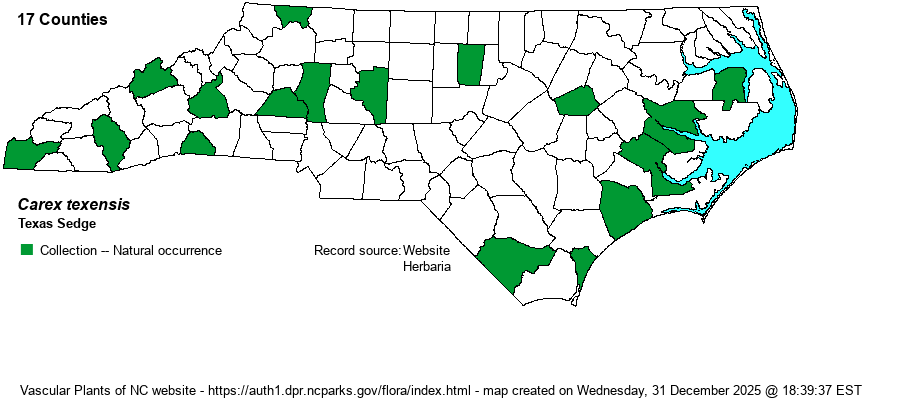| Author | (Torrey ex L.H. Bailey) L.H. Bailey | |
| Distribution | Scattered across the state, but with a broad gap in the Sandhills and upper-middle Coastal Plain. Likely overlooked.
NY to OH and KS, south to FL and TX. | |
| Abundance | Apparently uncommon throughout. This species is not well-known by NC botanists. The species seems not to have been ranked by the NCNHP; the website editors suggest S3. | |
| Habitat | Roadsides, clearings, fields, pastures, lawns, dry to mesic mixed woodlands and forests. Considering this often weedy set of habitats, its poorly documented range in NC is puzzling, especially the large gap in the Coastal Plain. | |
| Phenology | Flowering and fruiting April-May. | |
| Identification | Texas Sedge is closely similar to C. retroflexa and can be separated by narrower perigynia (1-1.3 mm wide vs. 1.4-1.8 mm wide). | |
| Taxonomic Comments | FNA (2002) says that C. texensis and C. retroflexa are not always clearly distinguished by available keys. A synonym is C. retroflexa var. texensis.
The genus Carex is the largest in North America, and among the largest in the world. In temperate and boreal regions, Carex is often the dominant or co-dominant ground layer in many habitats. Seeds (achenes) are valuable food for birds and small mammals, while foliage is used by birds and mammals to make nests and as food by mammals. Species of Carex often look vastly different from one another -- spikes erect vs. drooping, tiny inflorescence vs. whopping, culms leafy vs. naked, perigynia beaked vs. beakless, stems densely bunched vs. single, etc. The genus has been divided into many sections (or groups), based on shared characters; some taxonomists have suggested that these be different genera, but that proves unworkable (so far). All Carex share the feature of a perigynium (an outer covering) which completely surrounds the achene (seed). This covering may fit tightly or loosely (like a small bladder), depending on which group or species. Details of perigynia shape, ornamentation, presence and size of beak, number of striations (or veins) are all important ID features. In recent years Rob Naczi and colleagues have stressed the importance of arrangement of perigynia -- whether spiral (3+ ranks) or distichous (2-ranked) -- and have named a number of new species as well as split off some older synonyms. Therefore, RAB's (1968) key, excellent for its time, can only be used in a general way today. Members of some sections of Carex are difficult to key out (notably Ovales, Laxiflorae, Griseae); this is in part due to variation among individuals of a species, or failings of the key. FNA has drawings of most species and some species may be found in two or more places within a key, to acount for variability. New species to NC, and new to science(!), continue to be found in NC. | |
| Other Common Name(s) | None | |
| State Rank | [S3] | |
| Global Rank | G5 | |
| State Status | | |
| US Status | | |
| USACE-agcp | | |
| USACE-emp | | |

